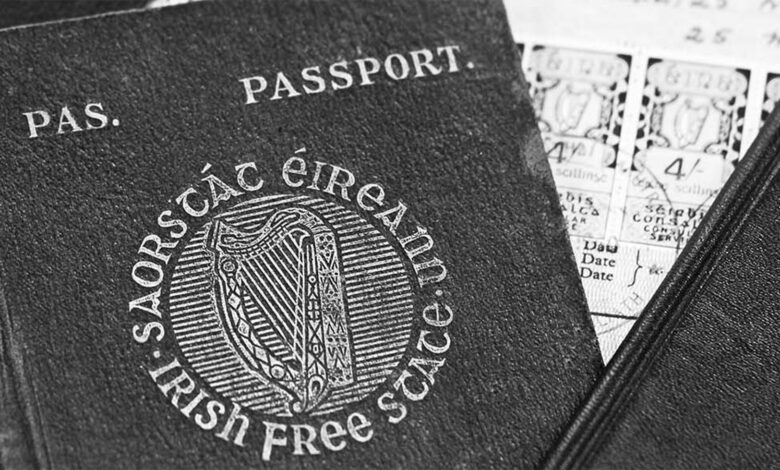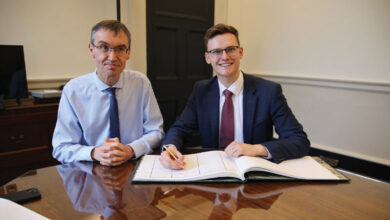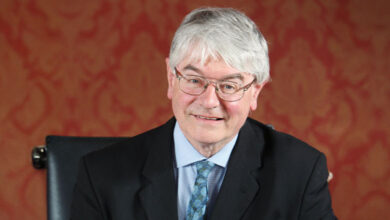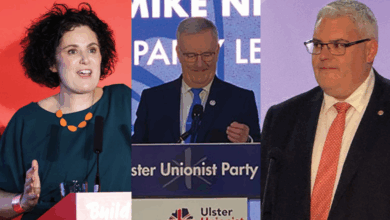A century on the move: The story of the Irish passport

Úna Fannon, Director of Operations with the Passport Service, reflects on the first century of the Irish passport, traces its evolution and looks ahead to the next century.
Over 100 years ago, on 3 April 1924, the Irish Free State began issuing passports to members of the public. What began as a handwritten document, green and embossed with a golden harp, has since evolved into one of the world’s most respected passports. In 2025, our passport is not only a symbol of Irish citizenship, but it also represents freedom of movement, national pride, and technological innovation.
To commemorate this centenary, the Department of Foreign Affairs and Trade has partnered with EPIC The Irish Emigration Museum, on a landmark exhibition entitled ‘On the Move – A Century of the Irish Passport’. This immersive display captures the passport’s evolution and its significance to the Irish people, drawing on personal stories and historical artefacts. The centenary has also been marked by a visual timeline illustrating the 100-year journey of the Irish passport, currently on display at the Passport Offices in Dublin and Cork.
From Saorstát Éireann to Éire
The first chapter in the Irish passport’s story begins in the fledging Irish Free State. The earliest passports bore “Saorstát Éireann, Irish Free State”. The passport held great symbolic weight, representing a new Ireland, forging its own path on the global stage. The first Irish passports were issued in 1923 to the Irish delegation travelling to Geneva to attend the League of Nations. That same year, WB Yeats travelled to Stockholm on an Irish passport to collect his Nobel Prize for Literature.
By 1939, the passport’s cover was updated to reflect Ireland’s new constitutional status: Éire, Ireland. Personal information appeared bilingually in Irish and English. These design changes were a visual symbol of Ireland’s growing independence.
European identity and digital innovation
The second major phase in the passport’s history coincided with Ireland joining the European Economic Community (EEC). Alongside other member states, Ireland began issuing a common EEC format passport in 1985, adopting a burgundy cover, and introducing new security features such as laminated photo and signature pages. The document’s security was further improved by the introduction of Machine-Readable Passports (MRP) in 1993, replacing the handwritten document.
Increased passport demand also prompted operational change for the Department. In 1987, a Passport Office opened in Cork. In 1992, the Passport Service issued 180,000 passports and by 2002, 537,000 passports were issued, leading to the expansion of the service and opening of a new office in Balbriggan, County Dublin.
A pivotal technological shift came in 2006 with the arrival of biometric ePassports, featuring a microchip embedded in a polycarbonate data page. The 2013 ePassport, filled with culturally resonant imagery from Irish history and landscapes, was awarded Document of the Year at the 2014 High Security Printing Conference.
“In 2025, our passport is not only a symbol of Irish citizenship, but it also represents freedom of movement, national pride, and technological innovation.”
Úna Fannon, Director of Operations, Passport Service
Online era
The third era in the Irish passport’s evolution centres around digital transformation. In 2015, the Passport Service launched a comprehensive Passport Reform and Modernisation Programme, prioritising efficiency, security, and citizen convenience.
A notable innovation during this time was the Passport Card, introduced in 2015. Designed for EU/EEA travel, this credit-card sized passport offered adult citizens convenient travel to 31 countries. Children’s passport cards followed in 2018.
The launch of Passport Online in 2017 marked a turning point. Initially available to adult renewals, Passport Online expanded in subsequent years to include child renewal applications and, eventually, first-time applications in Ireland and overseas. By 2022, over 90 per cent of applications were submitted online.
Today, Passport Online is available to 99 per cent of Irish citizens worldwide. The service allows photo uploads, digital verification, and streamlined delivery. Behind the scenes, the Passport Service’s Customer Service Hub responds to over 12,000 public queries weekly, ensuring an award-winning customer experience.
A powerful document in an interconnected world
The Irish passport is one of the most secure and respected travel documents in the world. Recently ranked third globally by the Henley Passport Index, our passport allows Irish citizens visa-free access to 189 destinations.
The passport’s growing popularity tells its own story. A record-breaking one million passports were issued in 2022, and again in 2024.
This growth reflects not only increased mobility, but a deep-rooted pride in Irish identity. Growing demand for the Irish passport reflects the increased diversity of Irish society, with those who have chosen to make Ireland their home expressing their commitment to the country by becoming Irish citizens. Demand for Irish passports from overseas applicants is also on the rise. For the Irish diaspora, which spans generations and continents, the passport is a tangible and valued connection to their Irish heritage.
Looking ahead
The centenary of the passport offers us the opportunity to celebrate how far we have come, and to look ahead to the exciting opportunities the future holds.
As we step into the next century of the Irish passport, innovation continues. Under the Passport Service’s Reform and Modernisation programme, a number of key projects that will future-proof service delivery, safeguard the integrity of the passport and enhance customer experience will be rolled out over the next 18 months.
A public consultation in 2023 on the future design of the passport resulted in 15,000 citizens selecting native Irish flora and fauna to be featured in the new passport book. The beautifully crafted and secure document is expected to be released in mid-2026.
Above all, the staff of the Passport Service, based at our offices in Dublin 2, Balbriggan, and Cork City look forward to continuing to deliver excellent service to our citizens.
________________________________________
‘On the Move – A Century of the Irish Passport’ is open now at EPIC The Irish Emigration Museum, and is proudly supported by the Emigrant Support Programme, Department of Foreign Affairs and Trade.





